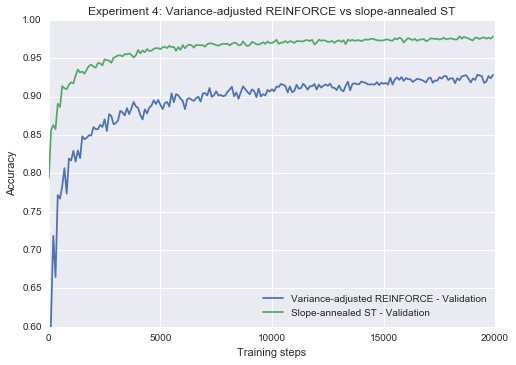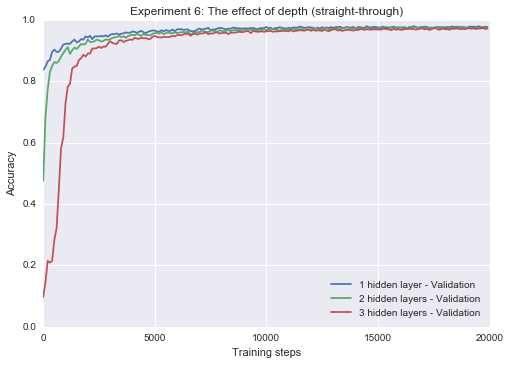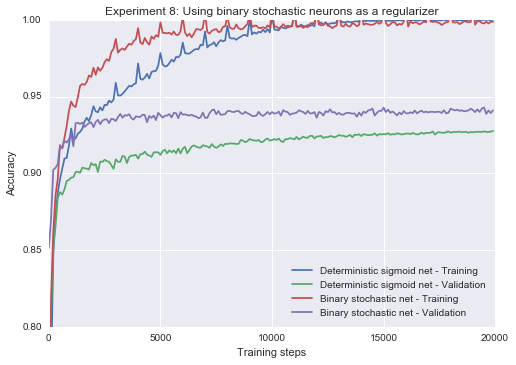In this post, I introduce and discuss binary stochastic neurons, implement trainable binary stochastic neurons in Tensorflow, and conduct several simple experiments on the MNIST dataset to get a feel for their behavior. Binary stochastic neurons offer two advantages over real-valued neurons: they can act as a regularizer and they enable conditional computation by enabling a network to make yes/no decisions. Conditional computation opens the door to new and exciting neural network architectures, such as the choice of experts architecture and heirarchical multiscale neural networks, which I plan to discuss in future posts.
The binary stochastic neuron
A binary stochastic neuron is a neuron with a noisy output: some proportion (p) of the time it outputs 1, otherwise 0. An easy way to turn a real-valued input, (a), into this proportion, (p), is to set (p = \text{sigm}(a)), where (\text{sigm}) is the logistic sigmoid, (\text{sigm}(x) = \frac{1}{1 + \exp(-x)}). Thus, we define the binary stochastic neuron, (\text{BSN}), as:
[\text{BSN}(a) = \textbf{1}_{z\ \lt\ \text{sigm}(a)}]
where (\textbf{1}_{x}) is the indicator function on the truth value of (x) and (z \sim U[0,1]).
Advantages of the binary stochastic neuron
-
A binary stochastic neuron is a noisy modification of the logistic sigmoid: instead of outputting (p), it outputs 1 with probability (p) and 0 otherwise. Noise generally serves as a regularizer (see, e.g., Srivastava et al. (2014) and Neelakantan et al. (2015)), and so we might expect the same from binary stochastic neurons as compared to the logistic neurons. Indeed, this is the claimed “unpublished result” from the end of Hinton et al.’s Coursera Lecture 9c, which I demonstrate empirically in this post.
-
Further, by enabling networks to make binary decisions, the binary stochastic neuron allows for conditional computation. This opens the door to some interesting new architectures. For example, instead of a mixture of experts architecture, which weights the outputs of several “expert” sub-networks and requires that all subnetworks be computed, we could use a choice of experts architecture, which conditionally uses expert sub-networks as needed. This architecture is implicitly proposed in Bengio et al. (2013), wherein the experiments use a choice of expert units architecture (i.e., a gated architecture where gates must be 1 or 0). Another example, proposed in Bengio et al. (2013) and implemented by Chung et al. (2016), is the Heirarchical Multiscale Recurrent Neural Network (HM-RNN) architecture, which achieves great results on language modelling tasks.
Training the binary stochastic neuron
For any single trial, the binary stochastic neuron generally has a derivative of 0 and cannot be trained by simple backpropagation. To see this, consider that if (z \neq \text{sigm}(a)) in the (\text{BSN}) function above, there exists a neighborhood around (a) such that the output of (\text{BSN}(a)) is unchanged (i.e., the derivative is 0). We get around this by estimating the derivative with respect to the expected loss, rather than calculating the derivative with respect to the outcome of a single trial. We can only estimate this derivative, because in any given trial, we only see the loss value with respect to the given noise – we don’t know what the loss would have been given another level of noise. We call a method that provides such an estimate an “estimator”. An estimator is unbiased if the expectation of its estimate equals the expectation of the derivative it is estimating; otherwise, it is biased.
In this post we implement the two estimators discussed in Bengio et al. (2013):
The REINFORCE estimator, which is an unbiased estimator and a special case of the REINFORCE algorithm discussed in Williams (1992). The REINFORCE estimator estimates the expectation of (\frac{\partial L}{\partial a}) as ((\text{BSN}(a) - \text{sigm}(a))(L - c)), where (c) is a constant. Bengio et al. (2013) proves that: [\mathbb{E}[(\text{BSN}(a) - \text{sigm}(a))(L - c)] = \mathbb{E}\big[\frac{\partial L}{\partial a}\big].] Bengio et al. (2013) further shows that to minimize the variance of the estimation, we choose: [c = \bar L = \frac{\mathbb{E}[\text{BSN}(a) - \text{sigm}(a))^2L]}{\mathbb{E}[\text{BSN}(a) - \text{sigm}(a))^2]}] which we can practically implement by keeping track of the numerator and denominator as a moving average. Interestingly, the REINFORCE estimator does not require any backpropagated loss gradient–it operates directly on the loss of the network. The straight through (ST) estimator, which is a biased estimator that was first proposed by Hinton et al.’s Coursera Lecture 9c. The ST estimator simply replaces the derivative factor used during backpropagation, (\frac{d\text{BSN}(a)}{da} = 0), with the identity function (\frac{d\text{BSN}(a)}{da} = 1). A variant of the ST estimator replaces the derivative factor with (\frac{d\text{BSN}(a)}{da} = \frac{d\text{sigm}(a)}{da}). Whereas Bengio et al. (2013) found that the former is more effective, the latter variant was successfully used in Chung et al. (2016) in combination with the slope-annealing trick and deterministic binary neurons (which we will see perform very similarly to, if not better than, stochastic binary neurons when used with slope-annealing). The slope-anealing trick modifies (\text{BSN}(a)) by first multiplying the input (a) by a slope (m) as follows: [\text{BSN}{\text{SL}(m)}(a) = \textbf{1}{z \lt \text{sigm}(ma)}.] Then, we increase the slope as training progresses and use (\frac{d\text{BSN}_{\text{SL}(m)}(a)}{da} = \frac{d\text{sigm}(ma)}{da}) when computing the gradient. The idea behind this is that as the slope increases, the logistic sigmoid approaches a step function, so that it’s derivative approaches the true derivative. All three variants are tested in this post.
Implementing the binary stochastic neuron in Tensorflow
The tricky part of implementing a binary stochastic neuron in Tensorflow is not the forward computation, but the implementation of the REINFORCE and straight through estimators. Each requires replacing the gradient of one or more Tensorflow operations. The official approach to this is to write a new op in C++, which seems wholly unnecessary. There are, however, two workable unofficial approaches, one of which is a trick credited to Sergey Ioffe, and another that uses gradient_override_map, an experimental feature of Tensorflow that is documented here. We will use gradient_override_map, which works well for our purposes.
Imports and Utility Functions
1 | |
Extracting MNIST_data/train-images-idx3-ubyte.gz Extracting MNIST_data/train-labels-idx1-ubyte.gz Extracting MNIST_data/t10k-images-idx3-ubyte.gz Extracting MNIST_data/t10k-labels-idx1-ubyte.gz
1 | |
def binaryRound(x): “”” Rounds a tensor whose values are in [0,1] to a tensor with values in {0, 1}, using the straight through estimator for the gradient. “”” g = tf.get_default_graph()
with ops.name_scope(“BinaryRound”) as name: with g.gradient_override_map({“Round”: “Identity”}): return tf.round(x, name=name)
# For Tensorflow v0.11 and below use: #with g.gradient_override_map({“Floor”: “Identity”}): # return tf.round(x, name=name)
1 | |
def passThroughSigmoid(x, slope=1): “"”Sigmoid that uses identity function as its gradient””” g = tf.get_default_graph() with ops.name_scope(“PassThroughSigmoid”) as name: with g.gradient_override_map({“Sigmoid”: “Identity”}): return tf.sigmoid(x, name=name)
def binaryStochastic_ST(x, slope_tensor=None, pass_through=True, stochastic=True): “”” Sigmoid followed by either a random sample from a bernoulli distribution according to the result (binary stochastic neuron) (default), or a sigmoid followed by a binary step function (if stochastic == False). Uses the straight through estimator. See https://arxiv.org/abs/1308.3432.
Arguments:
- x: the pre-activation / logit tensor
- slope_tensor: if passThrough==False, slope adjusts the slope of the sigmoid function for purposes of the Slope Annealing Trick (see http://arxiv.org/abs/1609.01704)
- pass_through: if True (default), gradient of the entire function is 1 or 0; if False, gradient of 1 is scaled by the gradient of the sigmoid (required if Slope Annealing Trick is used)
- stochastic: binary stochastic neuron if True (default), or step function if False “”” if slope_tensor is None: slope_tensor = tf.constant(1.0)
if pass_through: p = passThroughSigmoid(x) else: p = tf.sigmoid(slope_tensor*x)
if stochastic: return bernoulliSample(p) else: return binaryRound(p)
1 | |
def binaryStochastic_REINFORCE(x, stochastic = True, loss_op_name=”loss_by_example”): “”” Sigmoid followed by a random sample from a bernoulli distribution according to the result (binary stochastic neuron). Uses the REINFORCE estimator. See https://arxiv.org/abs/1308.3432.
NOTE: Requires a loss operation with name matching the argument for loss_op_name in the graph. This loss operation should be broken out by example (i.e., not a single number for the entire batch). “”” g = tf.get_default_graph()
with ops.name_scope(“BinaryStochasticREINFORCE”): with g.gradient_override_map({“Sigmoid”: “BinaryStochastic_REINFORCE”, “Ceil”: “Identity”}): p = tf.sigmoid(x)
reinforce_collection = g.get_collection(“REINFORCE”) if not reinforce_collection: g.add_to_collection(“REINFORCE”, {}) reinforce_collection = g.get_collection(“REINFORCE”) reinforce_collection[0][p.op.name] = loss_op_name
return tf.ceil(p - tf.random_uniform(tf.shape(x)))
@ops.RegisterGradient(“BinaryStochastic_REINFORCE”) def _binaryStochastic_REINFORCE(op, _): “"”Unbiased estimator for binary stochastic function based on REINFORCE.””” loss_op_name = op.graph.get_collection(“REINFORCE”)[0][op.name] loss_tensor = op.graph.get_operation_by_name(loss_op_name).outputs[0]
sub_tensor = op.outputs[0].consumers()[0].outputs[0] #subtraction tensor ceil_tensor = sub_tensor.consumers()[0].outputs[0] #ceiling tensor
outcome_diff = (ceil_tensor - op.outputs[0])
# Provides an early out if we want to avoid variance adjustment for # whatever reason (e.g., to show that variance adjustment helps) if op.graph.get_collection(“REINFORCE”)[0].get(“no_variance_adj”): return outcome_diff * tf.expand_dims(loss_tensor, 1)
outcome_diff_sq = tf.square(outcome_diff) outcome_diff_sq_r = tf.reduce_mean(outcome_diff_sq, reduction_indices=0) outcome_diff_sq_loss_r = tf.reduce_mean(outcome_diff_sq * tf.expand_dims(loss_tensor, 1), reduction_indices=0)
L_bar_num = tf.Variable(tf.zeros(outcome_diff_sq_r.get_shape()), trainable=False) L_bar_den = tf.Variable(tf.ones(outcome_diff_sq_r.get_shape()), trainable=False)
#Note: we already get a decent estimate of the average from the minibatch decay = 0.95 train_L_bar_num = tf.assign(L_bar_num, L_bar_numdecay +\ outcome_diff_sq_loss_r(1-decay)) train_L_bar_den = tf.assign(L_bar_den, L_bar_dendecay +\ outcome_diff_sq_r(1-decay))
with tf.control_dependencies([train_L_bar_num, train_L_bar_den]): L_bar = train_L_bar_num/(train_L_bar_den+1e-4) L = tf.tile(tf.expand_dims(loss_tensor,1), tf.constant([1,L_bar.get_shape().as_list()[0]])) return outcome_diff * (L - L_bar)
1 | |
def binary_wrapper(\ pre_activations_tensor, estimator=StochasticGradientEstimator.ST, stochastic_tensor=tf.constant(True), pass_through=True, slope_tensor=tf.constant(1.0)): “”” Turns a layer of pre-activations (logits) into a layer of binary stochastic neurons
Keyword arguments: *estimator: either ST or REINFORCE *stochastic_tensor: a boolean tensor indicating whether to sample from a bernoulli distribution (True, default) or use a step_function (e.g., for inference) *pass_through: for ST only - boolean as to whether to substitute identity derivative on the backprop (True, default), or whether to use the derivative of the sigmoid *slope_tensor: for ST only - tensor specifying the slope for purposes of slope annealing trick “””
if estimator == StochasticGradientEstimator.ST: if pass_through: return tf.cond(stochastic_tensor, lambda: binaryStochastic_ST(pre_activations_tensor), lambda: binaryStochastic_ST(pre_activations_tensor, stochastic=False)) else: return tf.cond(stochastic_tensor, pass_through=False), lambda: binaryStochastic_ST(pre_activations_tensor, slope_tensor = slope_tensor, pass_through=False, stochastic=False)) elif estimator == StochasticGradientEstimator.REINFORCE: # binaryStochastic_REINFORCE was designed to only be stochastic, so using the ST version # for the step fn for purposes of using step fn at evaluation / not for training return tf.cond(stochastic_tensor, lambda: binaryStochastic_REINFORCE(pre_activations_tensor), lambda: binaryStochastic_ST(pre_activations_tensor, stochastic=False))
else: raise ValueError(“Unrecognized estimator.”)
1 | |
def build_classifier(hidden_dims=[100], lr = 0.5, pass_through = True, non_binary = False, estimator = StochasticGradientEstimator.ST, no_var_adj=False): reset_graph() g = {}
if no_var_adj: tf.get_default_graph().add_to_collection(“REINFORCE”, {“no_variance_adj”: no_var_adj})
g[‘x’] = tf.placeholder(tf.float32, [None, 784], name=’x_placeholder’) g[‘y’] = tf.placeholder(tf.float32, [None, 10], name=’y_placeholder’) g[‘stochastic’] = tf.constant(True) g[‘slope’] = tf.constant(1.0)
g[‘layers’] = {0: g[‘x’]} hidden_layers = len(hidden_dims) dims = [784] + hidden_dims
for i in range(1, hidden_layers+1): with tf.variable_scope(“layer_” + str(i)): pre_activations = layer_linear(g[‘layers’][i-1], dims[i-1:i+1], scope=’layer_’ + str(i)) if non_binary: g[‘layers’][i] = tf.sigmoid(pre_activations) else: g[‘layers’][i] = binary_wrapper(pre_activations, estimator = estimator, pass_through = pass_through, stochastic_tensor = g[‘stochastic’], slope_tensor = g[‘slope’])
g[‘pred’] = layer_softmax(g[‘layers’][hidden_layers], [dims[-1], 10])
g[‘loss’] = -tf.reduce_mean(g[‘y’] * tf.log(g[‘pred’]),reduction_indices=1)
# named loss_by_example necessary for REINFORCE estimator tf.identity(g[‘loss’], name=”loss_by_example”)
g[‘ts’] = tf.train.GradientDescentOptimizer(lr).minimize(g[‘loss’])
g[‘accuracy’] = accuracy(g[‘y’], g[‘pred’])
g[‘init_op’] = tf.global_variables_initializer() return g
1 | |
def train_classifier(\ hidden_dims=[100,100], estimator=StochasticGradientEstimator.ST, stochastic_train=True, stochastic_eval=True, slope_annealing_rate=None, epochs=10, lr=0.5, non_binary=False, no_var_adj=False, train_set = mnist.train, val_set = mnist.validation, verbose=False, label=None): if slope_annealing_rate is None: g = build_classifier(hidden_dims=hidden_dims, lr=lr, pass_through=True, non_binary=non_binary, estimator=estimator, no_var_adj=no_var_adj) else: g = build_classifier(hidden_dims=hidden_dims, lr=lr, pass_through=False, non_binary=non_binary, estimator=estimator, no_var_adj=no_var_adj)
with tf.Session() as sess: sess.run(g[‘init_op’]) slope = 1 res_tr, res_val = [], [] for epoch in range(epochs): feed_dict={g[‘x’]: val_set.images, g[‘y’]: val_set.labels, g[‘stochastic’]: stochastic_eval, g[‘slope’]: slope} if verbose: print(“Epoch”, epoch, sess.run(g[‘accuracy’], feed_dict=feed_dict))
accuracy = 0 for i in range(1001): x, y = train_set.next_batch(50) feed_dict={g[‘x’]: x, g[‘y’]: y, g[‘stochastic’]: stochastic_train} acc, _ = sess.run([g[‘accuracy’],g[‘ts’]], feed_dict=feed_dict) accuracy += acc if i % 100 == 0 and i > 0: res_tr.append(accuracy/100) accuracy = 0 feed_dict={g[‘x’]: val_set.images, g[‘y’]: val_set.labels, g[‘stochastic’]: stochastic_eval, g[‘slope’]: slope} res_val.append(sess.run(g[‘accuracy’], feed_dict=feed_dict))
if slope_annealing_rate is not None: slope = slope*slope_annealing_rate if verbose: print(“Sigmoid slope:”, slope)
feed_dict={g[‘x’]: val_set.images, g[‘y’]: val_set.labels, g[‘stochastic’]: stochastic_eval, g[‘slope’]: slope} print(“Epoch”, epoch+1, sess.run(g[‘accuracy’], feed_dict=feed_dict)) if label is not None: return (res_tr, label + “ - Training”), (res_val, label + “ - Validation”) else: return [(res_tr, “Training”), (res_val, “Validation”)]
1 | |
res = train_classifier(hidden_dims=[100], epochs=20, lr=1.0, non_binary=True) plot_n(res, lower_y=0.8, title=”Logistic Sigmoid Baseline”)
Epoch 20 0.9698
1 | |
print(“Variance-adjusted:”) res1 = train_classifier(hidden_dims=[100], estimator=StochasticGradientEstimator.REINFORCE, epochs=3, lr=0.3, verbose=True) print(“Not variance-adjusted:”)and res2= train_classifier(hidden_dims=[100], estimator=StochasticGradientEstimator.REINFORCE, epochs=3, lr=0.3, no_var_adj=True, verbose=True)
1 | |
In terms of performance at lower learning rates, a learning rate of about 0.05 provided the best results. The results show that the variance-adjusted REINFORCE learns faster, but that its non-variance adjusted eventually catches up. This result is consistent with the mathematical result that they are both unbiased estimators. Performance is predictably worse than it was for the plain logistic sigmoid in Experiment 0, although there is almost no generalization gap, consistent with the hypothesis that binary stochastic neurons can act as regularizers.
1 | |
Epoch 20 0.9274 Epoch 20 0.923
1 | |
res1 = train_classifier(hidden_dims=[100], estimator=StochasticGradientEstimator.ST, epochs=20, lr=0.1, label = “Pass-through - 0.1”) res2 = train_classifier(hidden_dims=[100], estimator=StochasticGradientEstimator.ST, epochs=20, lr=0.1, slope_annealing_rate = 1.0, label = “Sigmoid-adjusted - 0.1”)
res3 = train_classifier(hidden_dims=[100], estimator=StochasticGradientEstimator.ST, epochs=20, lr=0.3, label = “Pass-through - 0.3”) res4 = train_classifier(hidden_dims=[100], estimator=StochasticGradientEstimator.ST, epochs=20, lr=0.3, slope_annealing_rate = 1.0, label = “Sigmoid-adjusted - 0.3”)
res5 = train_classifier(hidden_dims=[100], estimator=StochasticGradientEstimator.ST, epochs=20, lr=1.0, label = “Pass-through - 1.0”) res6 = train_classifier(hidden_dims=[100], estimator=StochasticGradientEstimator.ST, epochs=20, lr=1.0, slope_annealing_rate = 1.0, label = “Sigmoid-adjusted - 1.0”)
plot_n(res1[1:] + res2[1:] + res3[1:] + res4[1:] + res5[1:] + res6[1:], lower_y=0.4, title=”Experiment 2: Pass-through vs sigmoid-adjusted ST”)
1 | |

Experiment 3: Pass-through vs. slope-annealed ST estimation
Recall that Chung et al. (2016) improves upon the sigmoid-adjusted variant of the ST estimator by using the slope-annealing trick, which slowly increases the slope of the logistic sigmoid as training progresses. Using the slope-annealing trick with an annealing rate of 1.1 times per epoch (so the slope at epoch 20 is (1.1^{19} \approx 6.1)), we’re able to improve upon the sigmoid-adjusted ST estimator, and even beat our non-stochastic, non-binary baseline! Note that the slope annealed neuron used here is not the same as the one used by Chung et al. (2016), who employ a deterministic step function and use a hard sigmoid in place of a sigmoid for the backpropagation.
1 | |
Epoch 20 0.9548 Epoch 20 0.974 Epoch 20 0.9704 Epoch 20 0.9764 Epoch 20 0.9608 Epoch 20 0.9624
1 | |
res1 = train_classifier(hidden_dims=[100], estimator=StochasticGradientEstimator.REINFORCE, epochs=20, lr=0.05, label = “Variance-adjusted REINFORCE”)
res2 = train_classifier(hidden_dims=[100], estimator=StochasticGradientEstimator.ST, epochs=20, lr=0.3, slope_annealing_rate = 1.1, label = “Slope-annealed ST”)
plot_n(res1[1:] + res2[1:], lower_y=0.6, title=”Experiment 4: Variance-adjusted REINFORCE vs slope-annealed ST”)
1 | |

Experiment 5: A look at the deterministic step function, during training and evaluation
Similar to how dropout is not applied at inference when using dropout for training, it makes sense that we might replace the stochastic sigmoid with a deterministic step function at inference when using binary neurons. We might go even further than that, and use deterministic neurons during training, which is the approach taken by Chung et al. (2016). The following three combinations are compared below, using the slope-annealed straight through estimator, without slope annealing:
-
stochastic during training, stochastic during test
-
stochastic during training, deterministic during test
-
deterministic during training, deterministic during test
The results show that deterministic neurons train the fastest, but also display more overfitting and may not achieve the best final results. Stochastic inference and deterministic inference, when combined with stochastic training, are closely comparable. Similar results hold for the REINFORCE estimator.
1 | |
Epoch 20 0.9776 Epoch 20 0.977 Epoch 20 0.9704
1 | |
res1 = train_classifier(hidden_dims=[100], estimator=StochasticGradientEstimator.ST, epochs=20, lr=0.3, slope_annealing_rate=1.1, label = “1 hidden layer”) res2 = train_classifier(hidden_dims=[100, 100], estimator=StochasticGradientEstimator.ST, epochs=20, lr=0.3, slope_annealing_rate=1.1, label = “2 hidden layers”) res3 = train_classifier(hidden_dims=[100, 100, 100], estimator=StochasticGradientEstimator.ST, epochs=20, lr=0.3, slope_annealing_rate=1.1, label = “3 hidden layers”)
plot_n(res1[1:] + res2[1:] + res3[1:], title=”Experiment 6: The effect of depth (straight-through)”)
1 | |

1 | |
Epoch 20 0.9302 Epoch 20 0.8788 Epoch 20 0.2904
1 | |
res1 = train_classifier(hidden_dims=[100], epochs=50, non_binary=True, lr=0.002, label = “1 hidden layer”) res2 = train_classifier(hidden_dims=[100,100], epochs=50, non_binary=True, lr=0.002, label = “2 hidden layers”) res3 = train_classifier(hidden_dims=[100,100,100], epochs=50, non_binary=True, lr=0.002, label = “3 hidden layers”)
plot_n(res1[1:] + res2[1:] + res3[1:], title=”Experiment 6: The effect of depth (REINFORCE) (LR = 0.002)”)
1 | |

Experiment 7: Using binary stochastic neurons as a regularizer.
I now test the “unpublished result” put forth at the end of Hinton et al.’s Coursera Lecture 9c, which states that we can improve upon the performance of an overfitting multi-layer sigmoid net by turning its neurons binary stochastic neurons with a straight-through estimator.
To test the claim, we will need a dataset that is easier to overfit than MNIST, and so the following experiment uses the MNIST validation set for training (10x smaller than the MNIST training set and therefore much easier to overfit). The hidden layer size is also increased by a factor of 2 to increase overfitting.
We can see below that the stochastic net has a clear advantage in terms of both the generalization gap and training speed, ultimately resulting in a better final fit.
1 | |
Epoch 20 0.9276
Epoch 20 0.941
```

Conclusion
In this post we introduced, implemented and experimented with binary stochastic neurons in Tensorflow. We saw that the biased straight-through estimator generally outperforms the unbiased REINFORCE estimator, and can even outperform a non-stochastic, non-binary sigmoid net. We explored the variants of each estimator, and showed that the slope-annealed straight through estimator is better than other straight through variants, and that it is worth using the variance-adjusted REINFORCE estimator over the not variance-adjusted REINFORCE estimator. Finally, we explored the potential use for binary stochastic neurons as regularizers, and demonstrated that a stochastic binary network trained with the slope-annealed straight through estimator trains faster and generalizes better than an ordinary sigmoid net.